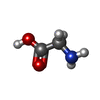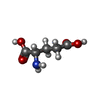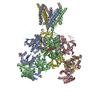+ Open data
Open data
- Basic information
Basic information
| Entry | Database: PDB / ID: 9d3b | |||||||||||||||||||||||||||
|---|---|---|---|---|---|---|---|---|---|---|---|---|---|---|---|---|---|---|---|---|---|---|---|---|---|---|---|---|
| Title | Gly-,Glu-,(S)-DQP-997-74 bound GluN1a-2B-2D NMDAR | |||||||||||||||||||||||||||
 Components Components | (Glutamate receptor ionotropic, NMDA ...) x 3 | |||||||||||||||||||||||||||
 Keywords Keywords | MEMBRANE PROTEIN / N-methyl-D-aspartate receptor / (S)-DQP-997-74 / GluN2B / GluN2D | |||||||||||||||||||||||||||
| Function / homology |  Function and homology information Function and homology informationregulation of sensory perception of pain / glycine-gated cation channel activity / excitatory chemical synaptic transmission / Activated NTRK2 signals through FYN / Synaptic adhesion-like molecules / response to glycine / propylene metabolic process / cellular response to L-glutamate / negative regulation of dendritic spine maintenance / Assembly and cell surface presentation of NMDA receptors ...regulation of sensory perception of pain / glycine-gated cation channel activity / excitatory chemical synaptic transmission / Activated NTRK2 signals through FYN / Synaptic adhesion-like molecules / response to glycine / propylene metabolic process / cellular response to L-glutamate / negative regulation of dendritic spine maintenance / Assembly and cell surface presentation of NMDA receptors / regulation of monoatomic cation transmembrane transport / NMDA glutamate receptor activity / voltage-gated monoatomic cation channel activity / NMDA selective glutamate receptor complex / Neurexins and neuroligins / glutamate binding / ligand-gated sodium channel activity / neurotransmitter receptor complex / glutamate receptor signaling pathway / calcium ion transmembrane import into cytosol / protein heterotetramerization / glycine binding / startle response / positive regulation of reactive oxygen species biosynthetic process / monoatomic cation transmembrane transport / Negative regulation of NMDA receptor-mediated neuronal transmission / Unblocking of NMDA receptors, glutamate binding and activation / positive regulation of calcium ion transport into cytosol / Long-term potentiation / excitatory synapse / monoatomic cation transport / regulation of neuronal synaptic plasticity / monoatomic ion channel complex / positive regulation of excitatory postsynaptic potential / synaptic cleft / positive regulation of synaptic transmission, glutamatergic / calcium ion homeostasis / MECP2 regulates neuronal receptors and channels / glutamate-gated receptor activity / presynaptic active zone membrane / glutamate-gated calcium ion channel activity / EPHB-mediated forward signaling / ligand-gated monoatomic ion channel activity involved in regulation of presynaptic membrane potential / sodium ion transmembrane transport / ionotropic glutamate receptor signaling pathway / Ras activation upon Ca2+ influx through NMDA receptor / synaptic membrane / hippocampal mossy fiber to CA3 synapse / adult locomotory behavior / regulation of membrane potential / excitatory postsynaptic potential / transmitter-gated monoatomic ion channel activity involved in regulation of postsynaptic membrane potential / synaptic transmission, glutamatergic / brain development / postsynaptic density membrane / visual learning / regulation of synaptic plasticity / calcium ion transmembrane transport / long-term synaptic potentiation / terminal bouton / synaptic vesicle / late endosome / signaling receptor activity / amyloid-beta binding / RAF/MAP kinase cascade / response to ethanol / chemical synaptic transmission / dendritic spine / postsynaptic membrane / learning or memory / cytoskeleton / calmodulin binding / lysosome / neuron projection / postsynaptic density / dendrite / calcium ion binding / synapse / endoplasmic reticulum membrane / protein-containing complex binding / glutamatergic synapse / cell surface / positive regulation of transcription by RNA polymerase II / zinc ion binding / plasma membrane / cytoplasm Similarity search - Function | |||||||||||||||||||||||||||
| Biological species |  Homo sapiens (human) Homo sapiens (human) | |||||||||||||||||||||||||||
| Method | ELECTRON MICROSCOPY / single particle reconstruction / cryo EM / Resolution: 3.71 Å | |||||||||||||||||||||||||||
 Authors Authors | Hyunook, K. / Hiro, F. | |||||||||||||||||||||||||||
| Funding support |  United States, 2items United States, 2items
| |||||||||||||||||||||||||||
 Citation Citation |  Journal: Neuron / Year: 2025 Journal: Neuron / Year: 2025Title: Structural basis for channel gating and blockade in tri-heteromeric GluN1-2B-2D NMDA receptor. Authors: Hyunook Kang / Max Epstein / Tue G Banke / Riley Perszyk / Noriko Simorowski / Srinu Paladugu / Dennis C Liotta / Stephen F Traynelis / Hiro Furukawa /  Abstract: Discrete activation of N-methyl-D-aspartate receptor (NMDAR) subtypes by glutamate and the co-agonist glycine is fundamental to neuroplasticity. A distinct variant, the tri-heteromeric receptor, ...Discrete activation of N-methyl-D-aspartate receptor (NMDAR) subtypes by glutamate and the co-agonist glycine is fundamental to neuroplasticity. A distinct variant, the tri-heteromeric receptor, comprising glycine-binding GluN1 and two types of glutamate-binding GluN2 subunits, exhibits unique pharmacological characteristics, notably enhanced sensitivity to the anti-depressant channel blocker S-(+)-ketamine. Despite its significance, the structural mechanisms underlying ligand gating and channel blockade of tri-heteromeric NMDARs remain poorly understood. Here, we identify and characterize tri-heteromeric GluN1-2B-2D NMDAR in the adult brain, resolving its structures in the activated, inhibited, and S-(+)-ketamine-blocked states. These structures reveal the ligand-dependent conformational dynamics that modulate the tension between the extracellular domain and transmembrane channels, governing channel gating and blockade. Additionally, we demonstrate that the inhibitor (S)-DQP-997-74 selectively decouples linker tension in GluN2D, offering insights into subtype-selective targeting for cognitive modulation. | |||||||||||||||||||||||||||
| History |
|
- Structure visualization
Structure visualization
| Structure viewer | Molecule:  Molmil Molmil Jmol/JSmol Jmol/JSmol |
|---|
- Downloads & links
Downloads & links
- Download
Download
| PDBx/mmCIF format |  9d3b.cif.gz 9d3b.cif.gz | 556.1 KB | Display |  PDBx/mmCIF format PDBx/mmCIF format |
|---|---|---|---|---|
| PDB format |  pdb9d3b.ent.gz pdb9d3b.ent.gz | Display |  PDB format PDB format | |
| PDBx/mmJSON format |  9d3b.json.gz 9d3b.json.gz | Tree view |  PDBx/mmJSON format PDBx/mmJSON format | |
| Others |  Other downloads Other downloads |
-Validation report
| Summary document |  9d3b_validation.pdf.gz 9d3b_validation.pdf.gz | 723.4 KB | Display |  wwPDB validaton report wwPDB validaton report |
|---|---|---|---|---|
| Full document |  9d3b_full_validation.pdf.gz 9d3b_full_validation.pdf.gz | 772.3 KB | Display | |
| Data in XML |  9d3b_validation.xml.gz 9d3b_validation.xml.gz | 62.6 KB | Display | |
| Data in CIF |  9d3b_validation.cif.gz 9d3b_validation.cif.gz | 92.8 KB | Display | |
| Arichive directory |  https://data.pdbj.org/pub/pdb/validation_reports/d3/9d3b https://data.pdbj.org/pub/pdb/validation_reports/d3/9d3b ftp://data.pdbj.org/pub/pdb/validation_reports/d3/9d3b ftp://data.pdbj.org/pub/pdb/validation_reports/d3/9d3b | HTTPS FTP |
-Related structure data
| Related structure data |  46530MC  9d37C  9d38C  9d39C  9d3aC  9d3cC M: map data used to model this data C: citing same article ( |
|---|---|
| Similar structure data | Similarity search - Function & homology  F&H Search F&H Search |
- Links
Links
- Assembly
Assembly
| Deposited unit | 
|
|---|---|
| 1 |
|
- Components
Components
-Glutamate receptor ionotropic, NMDA ... , 3 types, 4 molecules ACBD
| #1: Protein | Mass: 92691.828 Da / Num. of mol.: 2 / Mutation: R844N, R845G, K846A Source method: isolated from a genetically manipulated source Source: (gene. exp.)  Homo sapiens (human) / Gene: GRIN1, NMDAR1 / Production host: Homo sapiens (human) / Gene: GRIN1, NMDAR1 / Production host:  #2: Protein | | Mass: 98622.172 Da / Num. of mol.: 1 / Mutation: C588S, C838S, C849S Source method: isolated from a genetically manipulated source Details: Twin-Strep tag (WSHPQFEKGGGSGGGSGGSAWSHPQFEKGALVPRG) C-terminal p2A tag (GSGATNFSLLKQAGDVEENPG) Source: (gene. exp.)  Homo sapiens (human) / Gene: GRIN2B, NMDAR2B / Production host: Homo sapiens (human) / Gene: GRIN2B, NMDAR2B / Production host:  #3: Protein | | Mass: 94120.609 Da / Num. of mol.: 1 Source method: isolated from a genetically manipulated source Details: 1D4-tag (TETSQVAPA) / Source: (gene. exp.)  Homo sapiens (human) / Gene: GRIN2D, GluN2D, NMDAR2D / Production host: Homo sapiens (human) / Gene: GRIN2D, GluN2D, NMDAR2D / Production host:  |
|---|
-Sugars , 2 types, 4 molecules 
| #4: Polysaccharide | 2-acetamido-2-deoxy-beta-D-glucopyranose-(1-4)-2-acetamido-2-deoxy-beta-D-glucopyranose |
|---|---|
| #6: Sugar |
-Non-polymers , 3 types, 5 molecules 


| #5: Chemical | | #7: Chemical | #8: Chemical | ChemComp-A1A15 / | Mass: 572.387 Da / Num. of mol.: 1 / Source method: obtained synthetically / Formula: C28H21Cl2F2N3O4 / Feature type: SUBJECT OF INVESTIGATION |
|---|
-Details
| Has ligand of interest | Y |
|---|---|
| Has protein modification | Y |
-Experimental details
-Experiment
| Experiment | Method: ELECTRON MICROSCOPY |
|---|---|
| EM experiment | Aggregation state: PARTICLE / 3D reconstruction method: single particle reconstruction |
- Sample preparation
Sample preparation
| Component | Name: tri-heteromeric GluN1-2B-2D NMDAR / Type: COMPLEX / Entity ID: #1-#3 / Source: RECOMBINANT |
|---|---|
| Molecular weight | Value: 0.377 MDa / Experimental value: NO |
| Source (natural) | Organism:  Homo sapiens (human) Homo sapiens (human) |
| Source (recombinant) | Organism:  |
| Buffer solution | pH: 7.5 |
| Specimen | Conc.: 2 mg/ml / Embedding applied: NO / Shadowing applied: NO / Staining applied: NO / Vitrification applied: YES |
| Vitrification | Instrument: FEI VITROBOT MARK IV / Cryogen name: ETHANE / Humidity: 100 % / Chamber temperature: 278 K |
- Electron microscopy imaging
Electron microscopy imaging
| Experimental equipment |  Model: Titan Krios / Image courtesy: FEI Company |
|---|---|
| Microscopy | Model: FEI TITAN KRIOS |
| Electron gun | Electron source:  FIELD EMISSION GUN / Accelerating voltage: 300 kV / Illumination mode: FLOOD BEAM FIELD EMISSION GUN / Accelerating voltage: 300 kV / Illumination mode: FLOOD BEAM |
| Electron lens | Mode: BRIGHT FIELD / Nominal defocus max: 2200 nm / Nominal defocus min: 800 nm |
| Specimen holder | Cryogen: NITROGEN |
| Image recording | Electron dose: 61 e/Å2 / Film or detector model: GATAN K3 BIOQUANTUM (6k x 4k) |
| EM imaging optics | Energyfilter name: GIF Bioquantum / Energyfilter slit width: 14 eV |
- Processing
Processing
| EM software |
| ||||||||||||||||||||||||||||||
|---|---|---|---|---|---|---|---|---|---|---|---|---|---|---|---|---|---|---|---|---|---|---|---|---|---|---|---|---|---|---|---|
| CTF correction | Type: NONE | ||||||||||||||||||||||||||||||
| Particle selection | Num. of particles selected: 1317548 | ||||||||||||||||||||||||||||||
| Symmetry | Point symmetry: C1 (asymmetric) | ||||||||||||||||||||||||||||||
| 3D reconstruction | Resolution: 3.71 Å / Resolution method: FSC 0.143 CUT-OFF / Num. of particles: 100870 / Symmetry type: POINT | ||||||||||||||||||||||||||||||
| Atomic model building | Protocol: RIGID BODY FIT / Space: REAL | ||||||||||||||||||||||||||||||
| Atomic model building | 3D fitting-ID: 1 / Source name: PDB / Type: experimental model
| ||||||||||||||||||||||||||||||
| Refine LS restraints |
|
 Movie
Movie Controller
Controller











 PDBj
PDBj


















